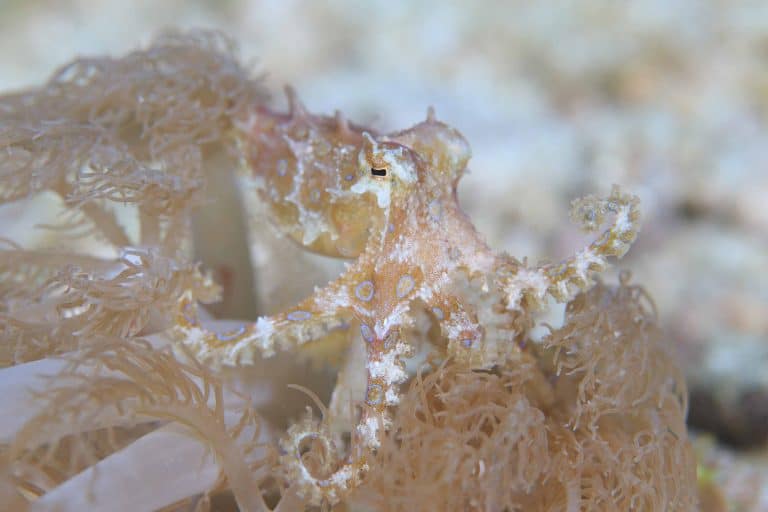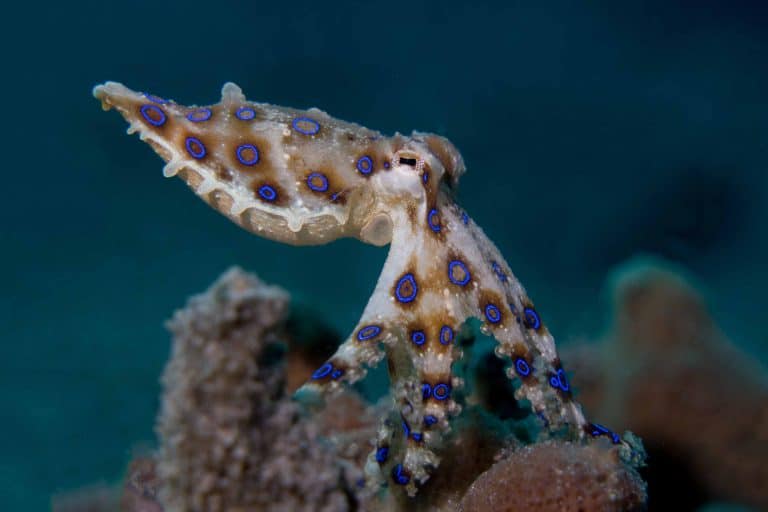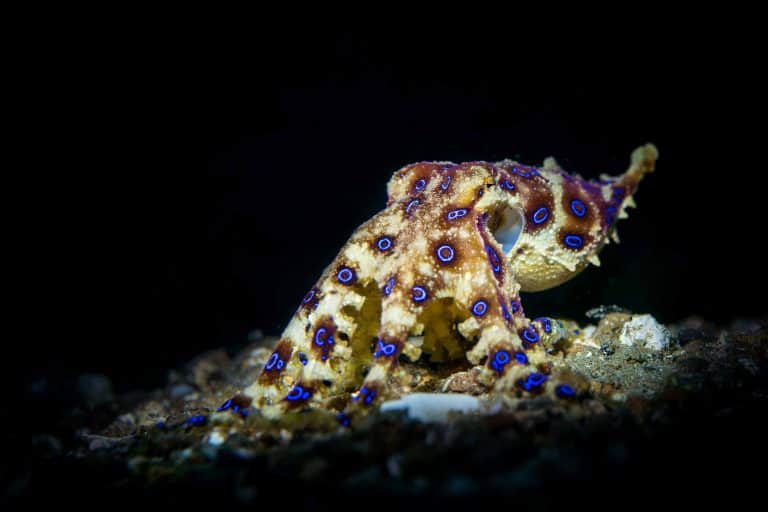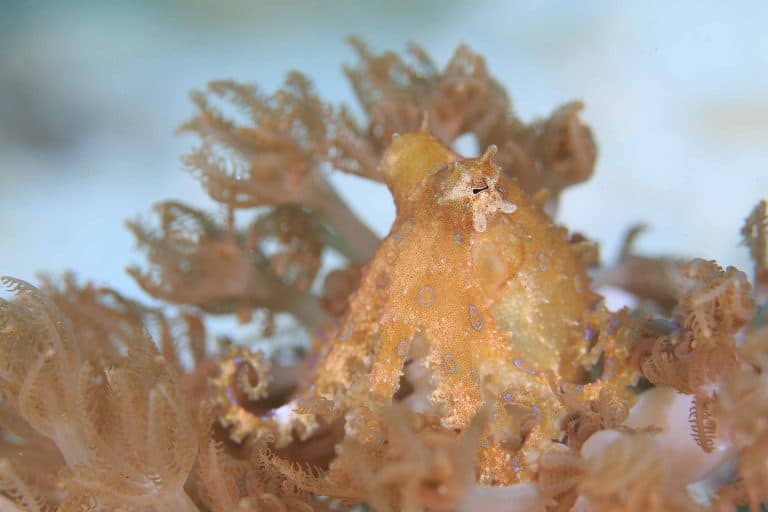Greater Blue-Ringed Octopus
Hapalochlaena lunulata
Messing with wild animals is never a good idea, but you really don’t want to bother a blue-ringed octopus. It’s one of the most venomous creatures in the animal kingdom! The venom is a neurotoxin that comes from bacteria in its saliva.
Fortunately, it’s easy to tell if this species is upset. If it suddenly turns banana-yellow with bright blue rings, that means, “Back off — now!”
Size
9 in long (22 cm)
Lifespan
2 years
Habitat
Shallow seas — reefs, seagrass, sand
Diet
Mostly crustaceans, but sometimes each other!
Range
Southwest Pacific Ocean, eastern Indian Ocean
Predators
Unknown
superpower
Deadly Bite
This octopus’s toxin can cause burning, numbness, muscle weakness, breathing problems, and even death in big enough doses!
SCIENTIFIC NAME: Hapalochlaena lunulata
The genus has four highly venomous species including the greater blue-ringed octopus (Hapalochlaena lunulata), the southern or lesser blue-ringed octopus (Hapalochlaena maculosa), blue-lined octopus with the first reliable record in 2015 (Hapalochlaena fasciata), and the fourth blue-ringed species (Hapalochlaena nierstraszi) documented and described from only two specimens located in the Bay of Bengal. There are potentially more species (at least 10 species!) belonging to this genus that are still being researched.

SIZE OF THE GREATER BLUE-RINGED OCTOPUS
This is a small to moderate-sized, muscular octopus. It has a reported total length to 220 mm, mantle length to 57 mm, and short arms around 2x the mantle length. There are around 60 suckers on each normal arm and 43 suckers on the hectocotylized arm.
GREATER BLUE-RINGED OCTOPUS LIFESPAN
Although this is a small species, they live for about 2 years!
DISTRIBUTION
This octopus inhabits Indo-Pacific waters from northern Australia, Papua New Guinea and the Solomon Islands, throughout the Philippines and Indonesia and as far west as Sri Lanka.

HABITAT
Blue-ringed octopuses inhabit shallow coastal waters on rocky and coral reefs, seagrass and algal beds. H. lunulata is found in sandy and silty areas among small corals and clumps of algae. This species has been collected from 0 to 50 m.
DIET
They mostly eat small crustaceans including crabs, shrimps, and hermit crabs. Several cases of cannibalism have been documented where juveniles have eaten other juveniles and adults have partially consumed other adults. A female was also observed eating a male after mating with him.

BODY PATTERNS AND BEHAVIORS
Blue-ringed octopuses are known for their small body size, yellowish skin with blue rings, and deadly venom. The body color is usually cream to yellow dark, a pair of white spots on the dorsal mantle (slightly anterior to midpoint of mantle), and the surface is covered with low papillae, giving it a rough texture.
This species has flap-like papillae in a diamond shape on mid-dorsal mantle and a large papilla on posterior tip of mantle. If they are provoked, they quickly change color (in less than 1 sec!), becoming bright yellow with each of the 50-60 iridescent blue rings flashing as a warning signal (back off, I’m venomous!). The fast flashes of the blue rings are achieved using muscles which are under neural control. The iridescent rings cover dorsal surfaces with the largest rings on the posterior dorsal mantle (up to 3.2 mm, 18% mantle length!).
Despite their small size, they are recognized as one of the world’s most venomous marine animals. Their saliva contains a powerful neurotoxin, tetrodotoxin (TTX) that is produced by bacteria. Blue-ringed octopuses have evolved a symbiotic relationship with the bacteria, providing them with ideal living conditions, in their salivary gland, while using the toxin they produce to paralyze prey and as part of their defense mechanism. This toxin is also distributed throughout the body organs and skin of this species. This neurotoxin is also found in pufferfish, and some poison dart frogs.
Since these animals occur in shallow coastal waters and in areas frequented by beach goers, bites and deaths have been reported. One milligram of TTX can kill a person, making it one of the most potent natural toxins known. The bite has been described as a small laceration with no more than a tiny drop of blood and usually painless. Sometimes the victim does not know they have been bitten until the onset of symptoms. Depending how much venom has been transferred, symptoms could develop within 5-10 min of the bite.
Victims can experience paresthesia and numbness, muscular weakness, difficulty breathing and swallowing. Nausea and vomiting, changes in vision, and difficulty speaking may also occur. In severe cases, these symptoms are followed by paralysis and respiratory failure. There is no antidote for TTX. Treatment consists of life-supportive measures including artificial ventilation.
This bite is considered a medical emergency. If you or someone you know has been bitten do not wait for symptoms to develop; quickly get the person bitten out of the water and, if possible, call 911 and consider transport to the nearest hospital. To avoid all of this, respect the octopus in its habitat. Look with your eyes and not your hands. Do not pick up or handle the octopus and be aware of your surroundings!

(Dr. Roy Caldwell) thecephalopodpage.org/bluering2.php
Mäthger, L.M.; Bell, G.R.; Kuzirian, A.M.; Allen, J.J. & Hanlon, R.T. (2012). “How does the blue-ringed octopus (Hapalochlaena lunulata) flash its blue rings?”. The Journal of Experimental Biology. 215 (21): 3752–3757. doi:10.1242/jeb.076869
Rudramurthy N and Sethi SN (November 2013). “Blue ring Octopus, Hapalochlaena nierstraszi, from the Bay of Bengal along the Chennai Coast” (PDF). Fishing Chimes. 33 (8): 82–83.
Jacups SP and Currie BJ (2008) Blue-ringed octopuses: a brief review of their toxicology. Northern Territory Naturalist 20:50-57.
Roper and Hochberg (1988), Cheng (1996), Norman and Sweeney (1997), Cheng and Caldwell (2000), Norman (2000), Williams and Caldwell (2009), Williams et al. (2011) in Jereb, P.; Roper, C.F.E.; Norman, M.D.; Julian K Finn (eds) Cephalopods of the world. An annotated and illustrated catalogue of cephalopod species known to date. Volume 3. Octopods and Vampire Squids. FAO Species Catalogue for Fishery Purposes. No. 4, Vol. 3. Rome, FAO. 2014. 370 p
Our mission is simple: We work to inspire wonder of the ocean by educating the world about octopuses.
We work with scientists, educators, and artists to make a global impact.
OctoNation® is a 501(c)(3) Nonprofit Organization